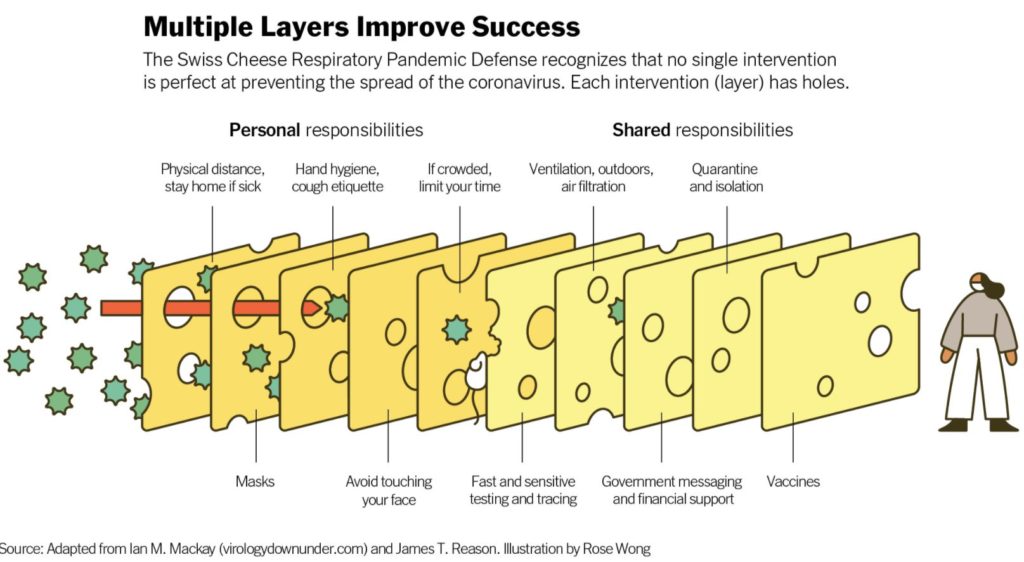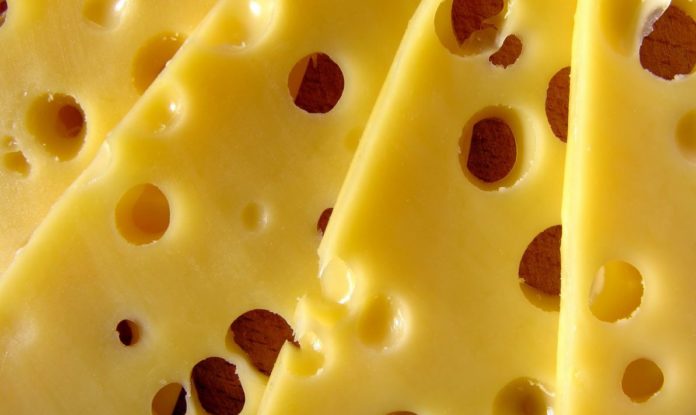Infectologists and epidemiologists have begun to use a new metaphor to refer to the care that people should take against the COVID-19 pandemic. The Swiss cheese model is illustrative, clear, and effectively explains how we can defend ourselves against the SARS-CoV-2 virus.
Imagine a delicious piece of Swiss cheese, like the ones that often appear in cartoons. If you cut it into several slices, you will find a few round holes in each of them. Now imagine that on one side of the cheese is the coronavirus that causes COVID-19; and, on the other, you are.
It may sound random, but there is a reasoning behind it. Think that each cut piece of cheese is care against the COVID-19 pandemic and each hole is the possible flaws that each collection may have. The more cares, or slices of cheese, side by side, the less holes will be discovered or, in other words, the less chance of contracting or spreading the virus.
Broadly speaking, it is the Swiss cheese model that infectologists and epidemiologists have begun to use to illustrate how best to protect themselves in the pandemic. And in short, the best ways to prevent COVID-19 is, as much as possible! Simultaneously.
How did the Swiss cheese model emerge?
In reality, the Swiss cheese model does not come from medicine or infectology, but from the area of risk analysis and management in the industrial field.
During the 1990s, British researcher James T. Reason from the University of Manchester created this model, also known as the cumulative effect model, to prevent accidents in high-risk workplaces.
His premise was simple: the more precautions are taken, the less chance there will be that things will go wrong. In his book “Human error“, he explains that security is a system and that errors will always exist since it is part of human beings, but if the mechanisms by which said system works are improved, errors can be avoided or, at least, lessen.
But how does this translate to the place of infectology?
How does the Swiss cheese model apply to the pandemic?
It was virologist Ian Mackay of the University of Queensland in western Australia who decided to take Reason’s model and think of it as a way to avoid “accidents” in the pandemic.
The underlying idea is the same: multiple slices of Swiss cheese – each with its possible contingencies – when put together, increase safety against disease.
Now, what are these slices? Mackey has divided Swiss cheese in two. On the one hand, there are the responsibilities that each person must assume individually (located to the left of the diagram), and on the other, the slices that correspond to collective responsibilities —which generally point to government authorities.

Individual preventive measures
- Physical distance: stay home if you are sick;
- Use a mask outside the home;
- Hand hygiene and care when coughing (use your elbow, never your hand, cover yourself with a handkerchief, etc.);
- Avoid touching your face;
- Avoid places where there are many people (supermarkets, fairs, pharmacies) or try to be there as little as possible.
Collective preventive measures
- Efficient case tracking and testing in the shortest possible time;
- Ensure ventilation and proper conditioning of closed spaces, and choose, if possible, to carry out activities outdoors.
- Government awareness campaigns, state support for the financing of COVID-19 prevention elements.
- Quarantine and preventive social isolation.
- Vaccinations
“The real power of this infographic – and James Reason’s view of human error – is that it’s not about any particular protection measure, but about increasing security as measures, or layers of cheese, are added”
Mackey explained to the New York Times.
By using a mask, a person can avoid infecting, or avoid becoming infected from those around them, Mackey exemplified, but it also has a high chance of failure, either because it is used incorrectly because the material is not the best, or because the size is small. All of these possible mistakes are holes, he said.
“To be as safe as possible, and to keep those around you safe, it’s important to increase the number of layers to prevent the virus from passing through them at all costs”
he summed up.
